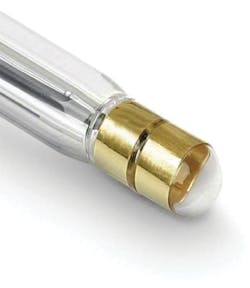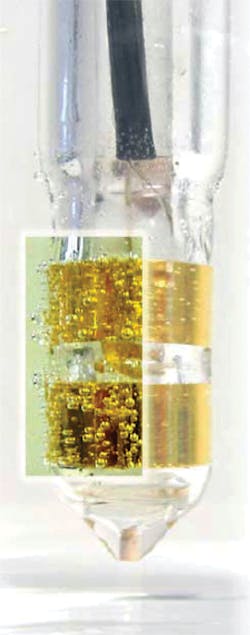A NEWLY DEVELOPED automatic cleaning method for potentiostatic sensors lowers operational costs and improves the reliability of disinfectants measurement and dosage in safety-critical potable water or wastewater applications. The new technology directly measures disinfectant concentration in a sample stream. It does not require the use of permeable membranes that can get coated or clogged, leading to inaccurate readings. The technology was recently used for disinfection of drinking water and continuous monitoring of chlorine concentration at a mountain ski resort in Maine. By replacing the existing membrane-based system with the new potentiostatic sensors, the company has greatly reduced maintenance costs and workload.
CHALLENGES OF CURRENT METHODS OF CONTROLLING DISINFECTANT DOSAGE
Disinfectants used in potable water or wastewater applications may include free chlorine, chlorine dioxide, or ozone. Commonly used alternatives for chemical measurement and dosage control include colorimetric analysis, amperometric measurement using a Clark-type sensor with membrane, and amperometric membrane-free potentiostatic sensor with direct exposure of the electrodes to the sample. Table 1 shows an overview of the advantages and disadvantages of these technologies.
Colorimetric analysis determines chemical concentration with the aid of a color reagent. Because this sampling system results in mineral and biological deposits, it requires a significant amount of maintenance, including changing tubes, valves, and containers. In addition, consumption of reagents adds considerably to the total cost of ownership.
Another option is the use of membrane-covered sensors with a Clark-type electrode, which measures the disinfectant concentration in a liquid using a net reaction principle between two electrodes. Clark sensors directly convert the specific ion concentration of a sample stream into an electrical sensor signal. They are used in conjunction with a permeable membrane, which protects the analytically active part of the sensor from direct contact with the sample and provides a controlled environment for the electrodes.
The molecules or ions to be measured have to pass the membrane to reach the electrodes, where the measured current gets generated by reduction. For the Clark sensor to function correctly, the membrane permeability must be undisrupted. Any coating on the membrane surface or clogging of its fine pores reduces membrane permeability, which leads to an inaccurate reading. This is especially critical in dosing applications, where inaccurate concentration readings could lead to an over-dosage of such health-critical agents as chlorine.
In addition, the membranes are prone to mechanical destruction and are difficult to clean. This issue is especially problematic in applications with substantial biological activity. If the sample stream stops, the biologically active components begin to grow, which can quickly lead to membrane pore clogging. Once this happens, the membrane cannot be recovered and has to be replaced. Another problem is the build-up of air bubbles at the membrane surface, which prevents the transfer of the molecules to the inner electrodes.
The final option available is potentiostatic measurement using membrane-free sensors, which eliminates problems caused by the membrane. Designed as a standard electrode with a 12-millimeter glass shaft, the potentiostatic sensor can be used in low-volume-flow cells available in different materials (see Figure 1).
A potentiostatic sensor measures the current flow between two electrodes that are in direct contact with the sample stream. A polarization layer is built on the upper gold electrode; target ions are reduced by this charge and result in a measuring current to the lower gold electrode. Analytically active components are in direct contact with the sample, so frequent cleaning is still required, but cleaning a solid gold surface is much easier than cleaning a highly sensitive membrane.
POTENTIOSTATIC MEASUREMENT REDUCES COSTS
Among the different technologies listed, amperometric methods are the most feasible, based on their comparatively lower investment and operational costs. The amperometric membrane-free potentiostatic sensors have significant advantages. The solid gold electrodes and the gel-filled sensor body are mechanically robust and insensitive to high operating pressures. The gold and glass materials used are biologically inert and highly resistant to chemicals (see Figure 2). Assembled in common flow vessels, the membrane-free sensor can be operated up to 87 psi (6 bar).
AUTOMATIC SENSOR CLEANING KEEPS ELECTRODE SURFACE CONTAMINATION-FREE
Since the potentiostatic sensor has two solid gold ring electrodes that are fully exposed to the sample stream, it is essential to have an effective cleaning method for keeping the electrode surfaces free from contamination. The most common cleaning method is using cleaning particles like sand or plastic beads, which swirl around the electrodes. It is quite a challenge to keep the particles in place around the sensor tip, making it impossible to use for direct installation of the sensor into pipelines. The method is also quite maintenance-intensive, requiring cleaning of the filters and exchange or refill of the beads. Mechanical cleaning methods often result in sensor down time. In addition, they have very little effect on oil and fat coatings.
A non-mechanical electrolysis-based cleaning method has recently been developed that can deal with these issues. The new sensor design, with two electrodes plus an ionic liquid in between, was developed by Dr. A. Kuntze, a global developer of water analysis technology. With the new cleaning method, the two gold electrodes are superposed with a slowly changing voltage. This causes electrolysis effects on the measurement electrodes, in which water molecules are being separated into hydrogen and oxygen. Both gases are strong oxygen reducing potential (ORP)-active reagents and can chemically degrade scale, rust, and manganese oxide, as well as oil and fat coatings. Furthermore, the gas generated by the ASR automatic sensor cleaning system is released as bubbles, which chip off even hard deposits from the surface of the electrodes (see Figure 3).
The use of membrane-free sensors in conjunction with the non-mechanical, automatic cleaning system eliminates the need for manual cleaning and provides nearly 100% measuring availability. This keeps operational costs and maintenance requirements to an absolute minimum.
NEW TECHNOLOGY USED FOR A MOUNTAIN SKI RESORT
The new system was successfully used by the Sugarloaf Water Association, a privately owned, non-profit water purveyor that delivers tap and fire suppression water to the Sugarloaf Resort Community in Maine. They needed a system for continuous monitoring of chlorine concentration. The company wanted to combine measurement of free chlorine and pH in one system and was seeking a way to reduce maintenance by using automatic sensor cleaning.
The chlorine content needs to be checked regularly to ensure that residual chlorine in the water is high enough to prevent contamination before the water is stored. The water also had to meet Maine’s maximum limit value for chlorine concentration. The chlorine value is tested once a day by a grab sample and lab test. However, in order to guarantee high water quality, the operator was also conducting continuous monitoring of the chlorine concentration at the pump station.
Sugarloaf Water Association previously used a membrane-covered amperometric sensor. Unfortunately, due to the water’s high mineral content (iron, manganese), sensor probe contamination was a major issue. The membrane clogged very quickly, and the operator needed to conduct weekly manual cleaning and monthly membrane exchange. In addition, the sensor drifted and had to be re-calibrated almost daily against lab test results. The water utility was therefore searching for a more reliable solution that required less maintenance.
KROHNE supplied the new OPTISYS CL 1100 analytical system for measuring free chlorine concentration, which offers automatic sensor cleaning using the ASR system. The pre-wired and completely mounted system contains an analytical transmitter, a membrane-free chlorine sensor, and valves. The automatic cleaning interval was increased from (typical) once a day to four times a day to handle the water’s high mineral content. After this adjustment, the chlorine value became very stable. Recalibration and manual cleaning were reduced to once a month, compared to a weekly manual cleaning and daily adjustment with the previous system.
After the successful test and evaluation period, the operator upgraded the system to include pH measurement, so they can now measure free chlorine concentration, pH value, and temperature all with one analytical system. The values are displayed and logged in Sugarloaf Mountain Water Association’s central control system. The company has greatly reduced maintenance costs and workload. Given that free chlorine and pH can be measured with one system, they no longer need to operate or service two different systems. Due to the system’s automatic cleaning feature, sensor clogging is no longer an issue. The maintenance interval is reduced to once a month, with no consumables (membrane or electrolyte) needed (see Figure 4).
NEW SENSORS PREVENT DOSAGE INCIDENTS AND REDUCE COSTS
The newly developed potentiostatic sensors for the most common disinfectants are the option least affected by coating in surface water and wastewater applications, preventing incidents, such as over dosage of chemicals. In combination with the patented automatic cleaning system, the new system keeps maintenance and operational costs to a minimum.
The overall system has high measuring availability and is fully automatic. Its long service intervals make it ideal for installation in unmanned water works, cooling towers, and safety critical applications such as gate warning systems in industrial wastewater treatment plants or desalination plants to protect sensitive instrumentation or processes against intolerable disinfectants concentrations.
About the Author
Thomas Roemer
Thomas Roemer is a business development manager for KROHNE Inc..




